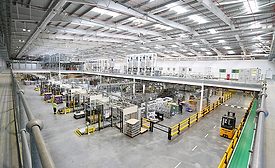Articles by Susan Sutton
Top 5 News that Sticks
Last week, readers were most interested in AkzoNobel’s announcement regarding a plan to increase in-house resin capacity.
Read More
From the Editor
A Wintery Mix
Our February issue brings articles on a wide range of topics, including green formulations and applications, curing materials, transportation end uses, and much more.
February 25, 2022
Top 5 News that Sticks
It’s a Hat Trick for H.B. Fuller
News from H.B. Fuller regarding recent acquisitions has garnered the most reader interest for the third consecutive week.
February 21, 2022
Top 5 News that Sticks
H.B. Fuller Acquisitions Continue to Dominate the News
Readers last week showed massive interest in H.B. Fuller’s latest acquisitions.
February 14, 2022
Top 5 News that Sticks
H.B. Fuller Retains Top Position with New Acquisitions Announcement
An announcement from H.B. Fuller regarding two acquisitions drew strong reader interest to keep the company in the top position for the second consecutive week.
February 7, 2022
Top 5 News that Sticks
H.B. Fuller Financial Results Draw Intense Reader Interest
Readers last week were massively drawn to an announcement from H.B. Fuller regarding its 2021 results.
January 31, 2022
From the Editor
Resolving Supply Chain Issues for the Adhesive and Sealant Industry
Participants in this issue’s supply chain roundtable discuss current challenges, specific materials that are experiencing supply shortages, end-use sector considerations, and projections for the future.
January 27, 2022
Top 5 News that Sticks
Readers Drawn to Latest Henkel Investment
Last week, an announcement from Henkel regarding an investment in the medical sector garnered the most reader interest.
January 24, 2022
Top 5 News that Sticks
Huntsman Initiatives are Top News
Readers last week were most interested in an announcement from Huntsman regarding the future of its Textile Effects Division, as well as a new executive compensation plan.
January 17, 2022
Ongoing Supply Chain Challenges Impacting the Adhesive and Sealant Industry
I recently reached out to key players in the industry to find out what supply chain issues are still in play and how companies are mitigating the various challenges, as well as their projections for the future.
January 10, 2022
Keep the info flowing with our eNewsletters!
Get the latest industry updates tailored your way.
JOIN TODAY!Copyright ©2025. All Rights Reserved BNP Media.
Design, CMS, Hosting & Web Development :: ePublishing









